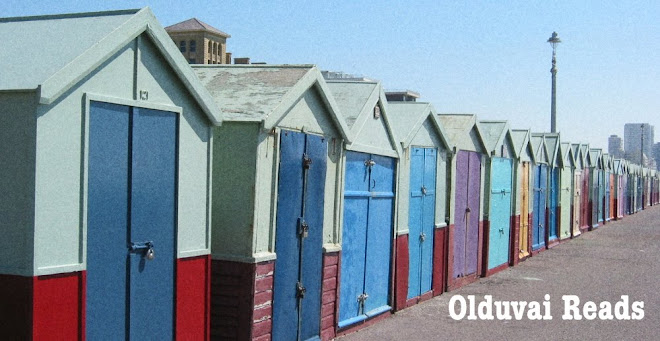I'm currently adoring George Saunders' Pastoralia, a collection of short stories both weird and wonderful. It opens with the one called Pastoralia - and its narrator is a caveman. Not in the Geico ad sense, but it's his job: he works as a caveman, in a theme park. He skins goats and picks insects and makes pictograms. But he's also got a fax machine in his 'Separate Area' where he gets updates from his wife back home. His cave partner is a woman named Janet, who unlike the narrator, doesn't give a damn about the park's rules. She uses English in the display area and talks to visitors. But the narrator tries to be a friend and in his Daily Partner Performance Evaluation:
'Do I not any attitudinal difficulties? I do not. How do I rate my Partner overall? Very good. Are there any situations which require Mediation?Management however, isn't quite so sure. And it's Staff Remixing time, where they explain in a note to the employees:
There are not.'
'we find ourselves in a too-many-Indians situation and so must first cut out some Indians and then, later, possibly, some chiefs. But not yet, because that is harder, because that is us. Soon, but not yet, we have to decide which of us to remove, and that is so very hard, because we are so very useful.'
Another weird and wonderful book that I'm loving is Sarah Vowell's Assassination Vacation, where she travels around America in search of assassins, political ones that is. I've been following as she traces the path of John Wilkes Booth, the actor who shot Abraham Lincoln. She visits the museum which holds the bullet (and fragments of Lincoln's skull) and tracks down the home of one his co-conspirators. Political murders so fill her world that her friend remarks:
'Assassinations are your Kevin Bacon. No matter what we're talking about, you will always the bring the conversation back to a president getting shot.'You gotta adore a writer who teaches her nephew the word 'decapitated' at Christmas when playing knights.
'Owen was winning. I was doubled over onto my parents' living room floor and he was pretending to slice my head off with his sword. Trying to be an educational aunt, or as educational as a person can be when a three-year-old is trying to chop her head off, I told him that the act of chopping off a person's head is called "decapitation" and that a head that's been chopped off is called "decapitated".'I am also plodding my way through Miguel de Cervantes' Don Quixote. It's very long and it's a little silly. And sometimes I wonder why I'm reading it. But it is quite entertaining although I'm only managing a few pages at a go. I suppose I'll finish it, eventually.
Jose Saramago is one of my favourite writers. I started with Blindness, worked my way through the Cave, and The Double, and now it's The Year of the Death of Ricardo Reis, set in Portugal in 1936. I've only just started so can't say much about it right now. But I have this fondness for Saramago's rambling sentences. Although, especially since reading Don Quixote, I do wonder about translated books. How does the translator capture the essence of the sentence, the original poetry of the words? How different would it be to read the original version?
I've also been just picked up Anais Nin's Henry and June. I've never read anything by her before so I figure now's as good a time as any to start. This book is from Nin's journal entries in the year she met Henry Miller and his wife June (1931-2).
And I've also just cracked open Richard Florida's Rise of the Creative Class: And How It's Transforming Work, Leisure, Community and Everyday Life. Although he has a more recent book, the Flight of the Creative Class, I wanted to begin with this one published in 2002. It's a little background reading for work. Essentially, it traces the growing role of creativity in America's economy: how people's values and tastes, choices of where to live are changing.
To round it all off, I am rereading, for what's probably the sixth time, Ursula K Le Guin's Earthsea Quartet. It's one of my all-time favourite reads. And there's always something comforting about rereading a good book. It's like coming home to people you know and love, and hearing stories you've heard over again but just can't wait to hear them one more time.

